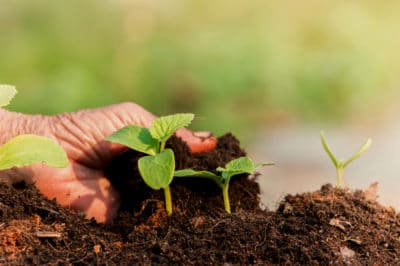Temperatures for Best Performance
Even if you’ve planted and germinated your seeds indoors in a warm location, setting them in the ground before the last spring frost can have a negative impact on the watermelon plant’s growth. Watermelons are very sensitive to cold and a blast of cold air can have plants failing to thrive or even die.
When spring temperatures reach their optimal level depends on where you live. Those living in a northern location where outdoor temperatures remain cooler for an extended period will have to wait a bit longer to plant seeds than those living in a more southern locale.
The best temperatures for planting seeds, germination and plant growth include:
- The best temperatures for germination are between 70°F to 95°F (21.1°C to 35°C). Germination occurs in a couple of days, when seeds are planted in 95°F (35°C) and can take a week, when planted in 70°F (21.1°C).
- Watermelons thrive when planted and grown with temperatures ranging between 70°F and 85°F (21.1°C and 29.4°C), but still handle temperatures of 90°F (32.2°C).
Expert Tip: Get a jump on watermelon season by planting seeds 1/2 inch deep in soil-filled peat pots two to four weeks before your last frost in spring. Wait until outdoor conditions are at their prime and plant the entire peat pot in the garden.
Varieties Based on Season’s Length
Where you live and the length of your warm growing season determines which watermelon cultivar is best-suited for your conditions. You don’t want to plant a variety that takes four months or longer to ripen if your season of guaranteed warmth only lasts for three.
However, with the hundreds upon hundreds of different watermelon varieties, there’s sure to be several that suits your desires when it comes to average days to harvest, color, size and habit of growth.
Short-Season Varieties:
- ‘Snack Pack’ produces 3- to 4-pound fruits, with dark green skin and red flesh. Matures in around 75 days.
- ‘Blacktail Mountain’ produces 6- to 12-pound, red-flesh fruit with dark green skin. More tolerant to cold and matures in around 70 days.
Mid-Season Varieties:
- ‘Strawberry’ is a hybrid producing sprawling vines and 15- to 20-pound, strawberry red-fleshed fruit with dark green-striped skin. Matures in 85 days and disease-resistant.
- ‘Sunray’ is a hybrid seedless producing yellow-fleshed, 13-pound fruits with light green-striped skin. Matures in around 85 days.
Long-Season Varieties:
- ‘Carolina Cross’ bears 200-pound, red-fleshed fruit with green-striped skin. Matures in around 100 days.
- ‘Orange Flesh Tendersweet’ produces orange-fleshed, 30- to 50-pound fruits with dark green skin with mottled stripes. Matures in 90 days.
Basic Planting Tips
Watermelons flower and fruit best planted in a sunny site and in well-drained, rich soil. If growing in containers, use at least a 5-gallon (18.9 liters) pot that has bottom drainage and fill with a well-drained potting mix.
Space multiple mounds about 3 feet apart and plant six seeds per mound, thinning to the hardiest three to four seedlings. If using rows, space multiple rows about 8 feet apart.
